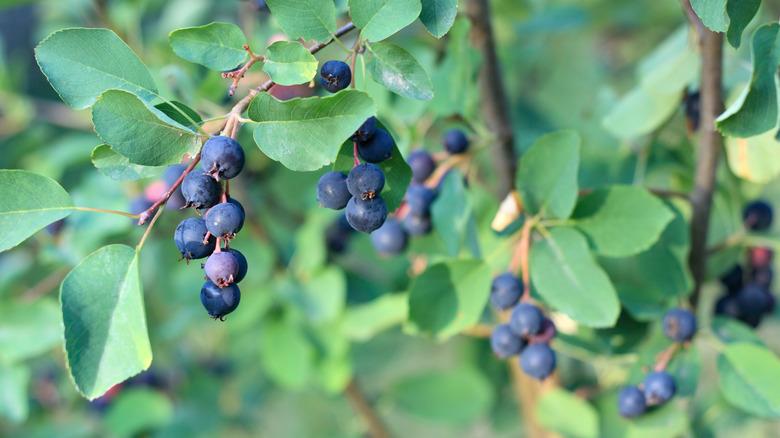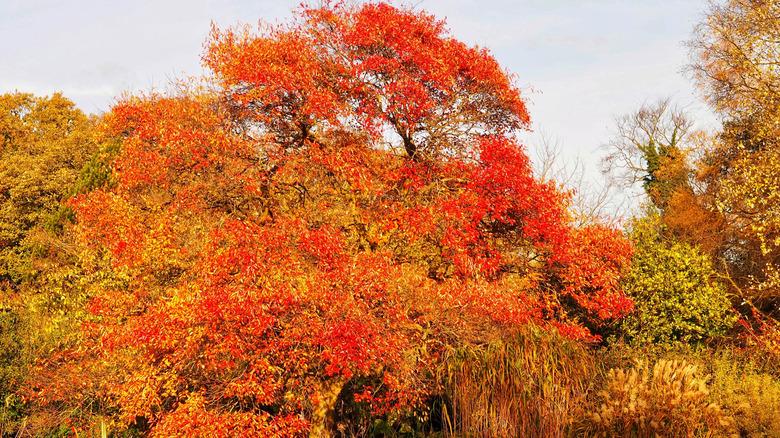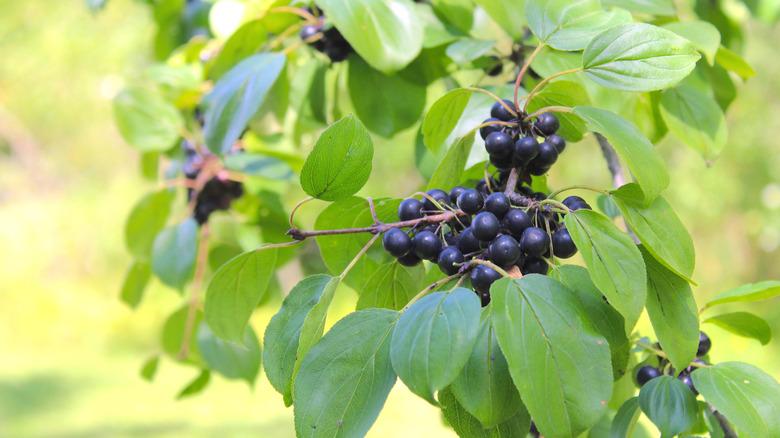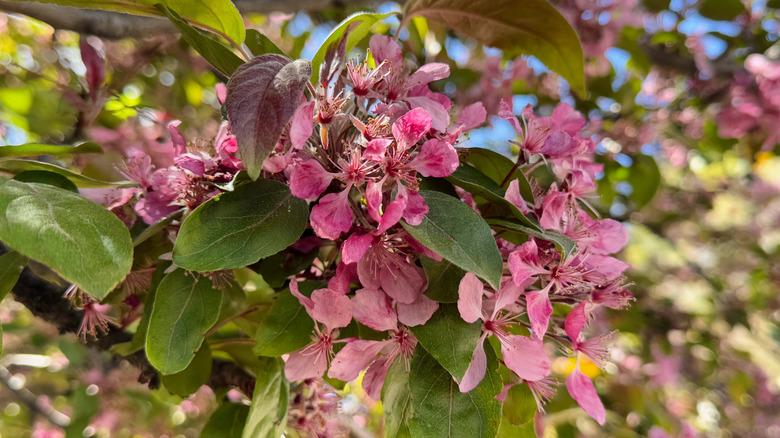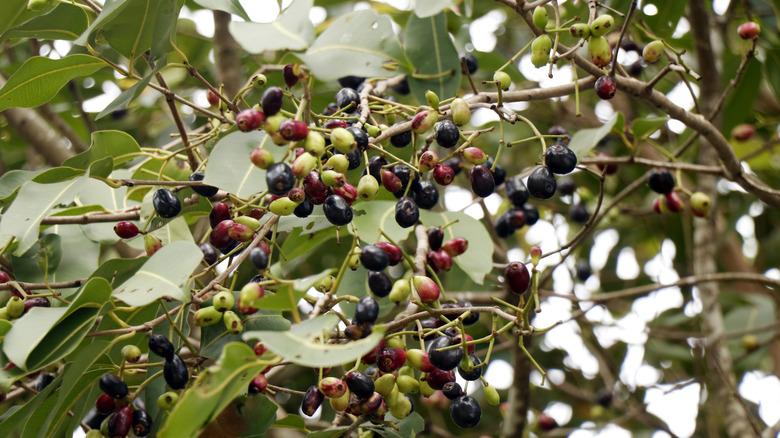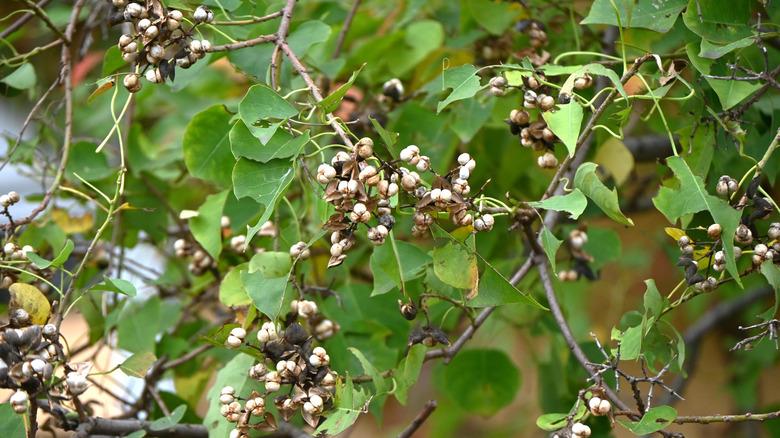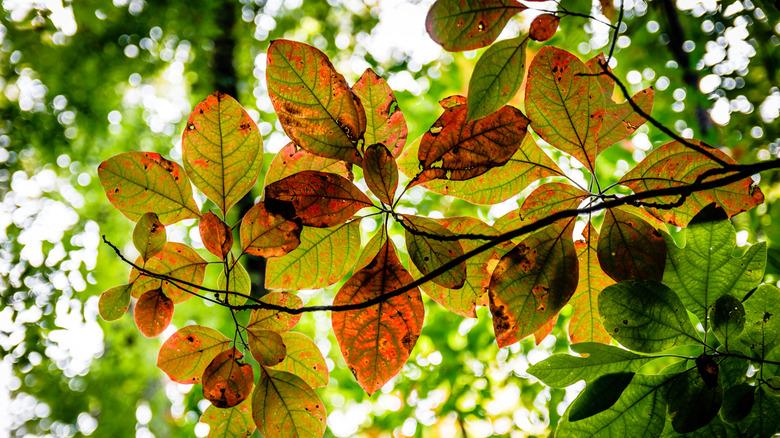Eight Fruit Trees You Should Rethink Growing And Eight You Should Try Instead
Johnny Appleseed got it right: the common apple tree (Malus domestica) is not native to North America, but it's also not considered invasive. Other fruit trees, however, are not so benign. Introduced by well-intended importers, non-native fruit trees can be invasive, crowding out native tree species and reducing the food sources and habitats of native birds, pollinators, and mammals. It is even illegal to plant some fruit trees, like white mulberries, in some states or local communities.
But even native fruit trees can also cause a mess, produce toxic fruits, or just stink up your yard. Next time you're thinking of adding a fruit tree to your yard, consider swapping out trees that can cause problems for those which have few if any downside. Even fruit trees that produce food inedible to humans will still give you the pleasure of watching native wildlife feast on the abundant fruits. So, before you go planting fruit trees, make sure you know what to plant — and what not to plant.
Avoid: Bradford pear
Bradford pear (Pyrus calleryana) is at the top of many "don't plant!" lists, and a number of southern states ban it completely. For good reason: Native to China and Vietnam, it is an invasive species in many parts of the United States, crowding out native trees. It's short-lived and its limbs are easily prone to breakage in storms. The white flowers it produces in early spring are beautiful but emit a foul odor. Its fruits are inedible to humans, even if birds love them.
Plant: Black tupelo
Black tupelo (Nyssa sylvatica) is an excellent alternative to the Bradford pear. Tupelo honey, made famous by the singer Van Morrison, is produced by honey bees that feast on tupelo nectar. Fruits ripen in the fall and can be eaten or chewed raw (though it's quite bitter) or cooked. But, leave the fruit on the tree and it will be an important food source for birds and other wildlife. The tree is hardy in U.S. hardiness zones 4 to 9, but may even thrive in the cold of zone 3. The black tupelo should be planted in medium to wet, acidic soils in full sun. To produce fruit, you need both a male and a female tree.
Avoid: White mulberry
In the Midwest and elsewhere, the white mulberry (Morus alba) is considered a noxious weed. It was brought to the U.S. from China in colonial times in a failed attempt to start a silk industry. It has been a bane ever since, proliferating on roadsides, fields, and forests. While birds love its fruits, they are inedible to humans, messy, and leave stains on pavements and cars.
Plant: Red mulberry
By contrast with the white mulberry, the red mulberry (Morus rubra) is better behaved. A native to North America, it is hardy in zones 4 to 9. Its abundant fruits can be eaten raw or made into jams and jellies, though unripe fruit should be avoided, as it has a low level of toxicity. It is easy to grow a red mulberry, as it thrives in rich, moist, well-draining soil in full sun or part shade. As noted above, some communities forbid planting any mulberry trees, so check with your local jurisdiction before planting this tree.
Avoid: European buckthorn
European buckthorn (Rhamnus cathartica) is an invasive species introduced in the United States from Europe in the early 1800s. Birds love its fruits, but they are mildly toxic to humans. It very easily self-seeds, grows quickly in a wide variety of soils and environments, and is difficult to eradicate, so it easily gets out of control. The dense shade it produces also prevents other plants from establishing.
Plant: Carolina buckthorn
Carolina buckthorn (Frangula caroliniana) is easy to grow as a shrub or a tall small tree that grows up to 20 feet tall. Despite its name, it is thornless. While its white flowers are relatively inconspicuous, birds love the fruits, and they may be edible to humans as well — though some say they can cause stomach upset, so beware. Hardy in zones 5 through 9, it should be planted in moist, well-draining, alkaline soil in full sun or part shade.
Avoid: Cherry plum tree
Sure, the cherry plum tree (Prunus cerasifera) is beautiful. It's a popular, widely cultivated tree native to western Asia and the Caucasus, but it grows fast and can be invasive and hard to eradicate once it escapes from cultivation. The fruits of the cherry plum tree are edible but not very palatable. It is also susceptible to Black Knot, a fungal disease. Its pits contain cyanide compounds that are toxic to humans and pets.
Plant: Wild plum
Though its flowers can be unpleasant smelling, the wild plum (Prunus americana) produces edible fruit often made into jellies or jams if you can harvest them before the birds get to them. This North American native can grow to 10 to 20 feet but can also be cultivated as a multi-stemmed shrub. Songbirds, small mammals, and pollinators use this tree for food and shelter. Hardy in zones 3 to 8, wild plums will tolerate a wide range of soils, but plant it in full sun or part shade.
Avoid: Fruiting crab apple tree
Deciding whether or not to plant a fruiting crab apple tree (Malus sylvestris) can be a matter of aesthetic trade-offs. It is often grown for its spring flower display and rarely for its fruits, which are much more tart than commercial apples. The fruit can make a mess of a yard or sidewalk once it falls to the ground and begins to rot. The tree is also susceptible to ugly fungi, blights, scabs, and other common diseases.
Plant: Flowering Dogwood
There are no aesthetic trade-offs with the flowering dogwood (Cornus florida), which adds four-season beauty to a garden. Its spring display of gorgeous flowers is followed by red fruits (inedible), which in turn are followed by stunning fall foliage. Native to North America, it is hardy in zones 5 to 9 and can tolerate a wide variety of acidic or neutral soils, but plant it in full sun or part shade to take advantage of what it has to offer.
Avoid: Sweet cherry
Sweet cherry (Prunus avium) might be called vigorous in the best of circumstances, but it is considered invasive in many areas of the United States. It produces abundant seeds that can out-compete native cherries, and once it's grown it can shade out competitors and be hard to control. Its seeds, leaves, and green fruits are poisonous. And unlike its many popular cultivars (such as the bing cherry) the original Prunus avium produces smaller and less-sweet fruits.
Plant: Serviceberry
The serviceberry (Amelanchier arborea) is a native fruit-bearing tree that is often overlooked by humans but not by birds and mammals, despite the fact that humans can eat the berries raw or cooked. It flowers early in spring with showy, white, mildly fragrant blooms. That show will be followed by the arrival of a wide variety of birds — bluebirds, waxwings, robins, orioles, cardinals, among others — which appreciate the early summer availability of its fruit. Hardy in zones 4 to 9, serviceberry trees should be planted in full sun to part shade in well-draining soil of any type.
Avoid: Java plum
Java plum (Syzygium cumini) came to Florida from Asia in 1911 and soon took over. Though a beautiful, tall tree whose fruits are known for their medicinal purposes, it is labeled as invasive in the state due to its fast-growing nature and its ability to shade out native trees. When its fruit accumulates on the ground and rots, the foul smell and the presence of flies can be a nuisance.
Plant: Blackhaw viburnum
Growing 15-feet-tall and nearly as wide, Blackhaw viburnum (Viburnum prunifolium) can fill a space as easily as the Java plum tree. In spring, its white flowers are fragrant, in summer its deep purple berries are beloved by humans and birds alike, and in fall its foliage turns to reds and purples. Hardy in zones 3 to 9, plant in full sun or part shade in medium, well-draining soil. Plant multiple plants for the best production of fruit.
Avoid: Chinese tallow
Chinese tallow (Triadica sebifera) is attractive with bright red foliage in the fall, and it has been used in Asian herbal medicines for centuries. Yet it's invasive in many parts of the United States, as it easily spreads by suckers emerging from its roots, and when its branches are damaged, it emits a milky white sap that's poisonous. Its stems, leaves, and fruit are also poisonous. Fast-growing and tolerant of all too many environments, it's not to be trifled with.
Plant: Sassafras
Like Chinese tallow, the North American native sassafras tree (Sassafras albidum) is used in herbal medicines and its leaves will turn red in the fall. But its scent is aromatic and fruits can be eaten by birds and mammals, including humans, who have long made it into teas and other drinks, including root beer. Its leaves are ground into filé powder, a central ingredient in gumbo. The sassafras tree grows easily to a height of 30 to 50 feet. Plant it in full sun to part shade in zones 4 to 9 in well-draining soil.
